

| Patriarch Mor Aphrem-II | Syriac Orthodox Church | Catholicos Mor Thomas-I | Church in India | Canonized Fathers | Patriarchs in India | Catholicate | India Link |
India Visit: | News | Photos | Videos | Articles |
PATRIARCHS OF THE APOSTOLIC SEE OF ANTIOCH WHO HAD VISITED INDIA
Part I - Patriarchs of the Apostolic See of Antioch who had visited India
Patriarchs of the Apostolic See of Antioch who had visited India
The Syrian Church in India which is believed to have been established by Apostle St. Thomas in AD 52 continues to be in the Orthodox faith primarily because of the sacrifices of many of the Syrian fathers of yesteryears who came here ignoring great difficulties for which the Malankara Syrian Christians are greatly indebted. The strength, power, glory, growth and the very existence of Malankara Syrian Church is unequivocally related to these holy fathers, many of whose identity are unknown. Scarcity of the church records of the pre-Portuguese era is the major obstacle in getting the complete list of these Holy fathers. However there is a strong historical reference to the arrival of a Syrian Orthodox Metropolitan named Mor Youseph in AD 345, who reached Malabar/Malankara along with Thomas Cana (Kanai Thoma) from Edessa (in the present Turkey). Later many prelates have been sent by the Patriarchs of Antioch on the request of the Syrian Christians of Malankara, some of the widely venerated among there are Maphriyono St. Baselios Yeldho (Kothamangalam), St. Gregorios of Jerusalem (N. Paravur), Maphriyono Mor Baselios Shakralla (Kandanad), Mor Kurillos Yuyakkim (Mulanthuruthy) and St. Osthatheos Sleebo (Kunnamkulam). Though the list of Syrian Metropolitans who came here are many, only five heads of the Church had visited Malankara, that too in the last 2 centuries and Moran Mor Ignatius Zakka I Iwas is the only Church head who visits India more than once, thanks to the better transportation facilities of the 20th century.
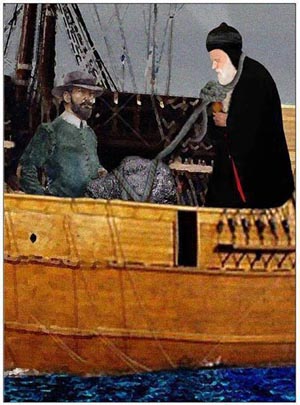 Patriarch Moran Mor Ignatius Ahattulla (Abdulla
of Turabdin-1653)
Patriarch Moran Mor Ignatius Ahattulla (Abdulla
of Turabdin-1653)
In fact the first known Syrian Orthodox Patriarch who set out to reach his flock in Malankara was Moran Mor Ignatius Ahattulla (Abdulla of Turabdin), but enroute he was imprisoned by the Portuguese navy and was murdered and drowned in sea in AD. 1653, an incident which resulted in a massive revolt by the native Syrian Christians against the Portuguese and their Roman Catholic counterparts. As and when the news about this brutal murder of their spiritual leader spread, the agitated Syrian Christians numbering about 25000, assembled at Mattancherry near Cochin and took oath to protect their Church from the illegitimate dominance of Roman Bishops, a problem that was haunting them more than a century, and vowed to ever remain loyal to the Holy Apostolic See of Antioch, maintaining their ancient rites and traditions, which their forefathers were very keen to follow. This landmark event is recorded in the history as 'Koonan Kurizu Sathyam' (Oath at the leaning Cross). The Syrian fathers who subsequently came to Malankara helped to reestablish the Orthodox faith and the Holy church was rebuilt once again.
The strength, power, glory, growth and the very existence of Malankara Syrian Church is unequivocally related to the holy fathers of yore who against all odds and impediments reached here and guided us from time to time in order to uphold Petrine Succession with the stamp of authentic apostolic entity. The faith, priesthood, liturgy, rites, rituals and practices, hierarchic protocols, the appellations and vestments – everything has been of the Antiochean Church. The sacrifices made on our behalf by the Syrian holy fathers are legendary.
The holy Patriarchs of Antioch & all the East who had visited India:
| 1. MORAN MOR IGNATIUS PETER IV |
| Patriarch of Antioch (1872-1894) |
Though many
Syrian fathers came to Malankara after the untoward incident of 1653, the first
Patriarch of Antioch who visited this land was Moran Mor 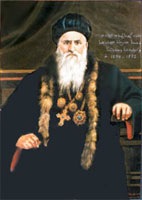 Ignatius
Peter IV (also known as Pethros III in Malankara) in 1875.
Ignatius
Peter IV (also known as Pethros III in Malankara) in 1875.
The credit for the end of the discrimination by the British missionaries goes to this Patriarch. It was he who introduced a democratic system of administration in the Malankara Church through the formation of the 'Jacobite Syrian Christian Association'. The historic Mulanthuruthy Synod which took this important decision was held in A.D. 1876 under the presidency of His Holiness. Later the Patriarch ordained six Metropolitans of which one was the St. Gregorios Geevarghese (Parumala Thirumeni), his private secretary.
On 27 August 1876, His Holiness consecrated Holy Mooron at the Mulanthuruthy Marthoman Church. This was the first time in the history of the Church the Holy Mooron was consecrated in Malankara. After staying in Malankara for 2 years the Patriarch returned in 1877. He died on 8th October 1894 (M.E. 1070 'Kanni' 25) and was entombed at the Mor Gabriel monastery (Kurkuma Dayro) at Turabdin in Turkey.
| Patriarch of Antioch 1906-1915 |
In 1909 came
the Patriarch Moran
Mor Ignatius Abded 'Aloho. He stayed here for almost 2 years in quest of
solving the 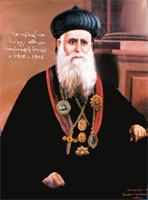 problems
in the Indian Church. During his apostolic visit, H.H. ordained two
Metropolitans, St.
Athanasius Paulose (Valiya
Thirumeni of Malankara) on June 9, 1910 at Akaparambu
Church and Mor
Severious Geevarghese (Edavazhikal)
of Knanaya diocese on August 28, 1910. On 19 August 1911, the Holy Mooron was
consecrated for the second time in Malankara which was again at the Mulanthuruthy
Marthoman Church.
problems
in the Indian Church. During his apostolic visit, H.H. ordained two
Metropolitans, St.
Athanasius Paulose (Valiya
Thirumeni of Malankara) on June 9, 1910 at Akaparambu
Church and Mor
Severious Geevarghese (Edavazhikal)
of Knanaya diocese on August 28, 1910. On 19 August 1911, the Holy Mooron was
consecrated for the second time in Malankara which was again at the Mulanthuruthy
Marthoman Church.
On 30 August 1911 the Malankara Association was convened at Aluva under the presidency of His Holiness the Patriarch. It was this convention, held for three consecutive days, which elected Mor Koorilose Paulose (Kochuparambil) as the Malankara Metropolitan. The Patriarch returned on 14 October 1911. He died on 9 December 1915 and was entombed at St. Mark's Dayro, Jerusalem.
| Patriarch of Antioch 1917-1932 |
In 1931 came
the Holy Patriarch of Antioch & all the East Moran
Mor Ignatius Elias III. His mission in Malankara was to bring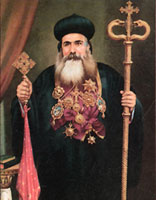 peace
in the divided church. H.H. traveled throughout Malankara and held several
round of talks in this process. But the Holy Father's extensive tour and severe
mental agony he had to face, weakened him physically and mentally. On 13
February 1932 H.H. entered into eternal rest during his stay at the Mor
Stephanos church. The same morning while offering the Holy Qurbono, the Holy
Father during the sermon said "We came to India with the sole purpose of
ushering peace and open the Door of Peace, but sorry, all our efforts are in
vein.... We are extremely unhappy to see our own limbs, is being lost! Our heart
is breaking.... we would never forget your loyalty to the Holy See. We are
confident that we would be with our Lord in His majestic second coming; May God
bless you all and your families...." It was at 2.30 in the evening the Holy
father passed away. The mortal remains of the holy Patriarch was entombed at Mor
Ignatius Dayro at
Majanikkara on 14th.
peace
in the divided church. H.H. traveled throughout Malankara and held several
round of talks in this process. But the Holy Father's extensive tour and severe
mental agony he had to face, weakened him physically and mentally. On 13
February 1932 H.H. entered into eternal rest during his stay at the Mor
Stephanos church. The same morning while offering the Holy Qurbono, the Holy
Father during the sermon said "We came to India with the sole purpose of
ushering peace and open the Door of Peace, but sorry, all our efforts are in
vein.... We are extremely unhappy to see our own limbs, is being lost! Our heart
is breaking.... we would never forget your loyalty to the Holy See. We are
confident that we would be with our Lord in His majestic second coming; May God
bless you all and your families...." It was at 2.30 in the evening the Holy
father passed away. The mortal remains of the holy Patriarch was entombed at Mor
Ignatius Dayro at
Majanikkara on 14th.
While in Malankara, the Holy Father had once convened a Church delegates meeting at Kuruppumpady, which is popularly known as the Kuruppumpady Yogam, on 5 July 1931. This was the 3rd time a Patriarch of Antioch had been presiding in a Malankara Association meeting.
The memory of the holy Patriarch is revered throughout the Syriac Orthodox Church and especially in Malankara where thousands of pilgrims reach the tomb, by foot, on the annual feast day, from various parts of the Kerala state. He is the only Patriarch of Antioch whose remains are interred in Malankara and his tomb stands as a towering symbol of the sacrifices made by the Syriac fathers to nurture the church in Malankara. The Saintly Patriarch's name is remembered in the fifth diptych since 1987.
(Biography of the Holy father is available at http://sor.cua.edu/Personage/PElias3/index.html)
| 4. MORAN MOR IGNATIUS YAKUB III |
| Patriarch of Antioch 1957-1980 |
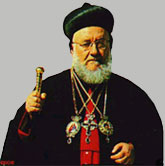 |
Three decades later, Patriarch Moran Mor Ignatius Yakub III visited Malankara with a mission to consecrate a new Catholicose for the reunited Malankara Church. On 22 May 1964 H.H. consecrated the first Canonical Catholicose by name Mor Baselios Augen I, for Malankara, at the Mar Elia Chapel, Kottayam. Incidentally, Mor Severios Zakka, the present Patriarch of Antioch was one of the co-celebrants in the consecration ceremony. The Patriarch left India the next month.
|
(Right) H.H. the Patriarch Mor Yakub III installs Mor Augen as the Catholicos of the East at Kottayam. |
| (Left) The Catholicos-designate Mor Augen reading the Pledge of Loyalty to the Holy See |
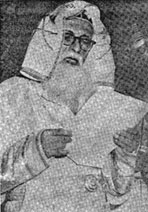 |
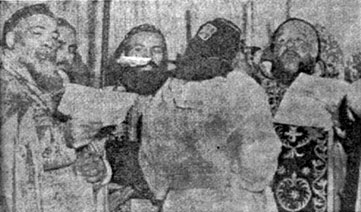 |
|
Pledge by Mor Augen during his Catholicos consecration: “ I the feeble and meak Augen Mor Themotios chosen for ecclesiastical office of the Catholicos confess my belief before the Synod, and before the head of the Synod His Holiness Moran Mor Ignatius Yacoub III Patriarch of Antioch and all the East that, the Patriarch is my head, that I accept from St.Peter the head of Holy Apostles upto your Holiness all the canonical Patriarchs who reigned on your Throne and all those who come after your Holiness. Once again I repeat my canonical connections with the Holy Throne of Antioch. I swear that I shall not depart from this solemn oath.” |
|
Though as the supreme head of the Universal Syrian Orthodox Church, it was his first visit, as Rabban Abdul Ahad, he had been at Majanikkara Dayro for many years teaching Syriac and theology for the seminarians.
On 7 September 1975, H.H. ordained the second Catholicose for Malankara Mor Baselios Paulose II at the Patriarchal cathedral, Damascus. H.H. passed away on 25th June 1980 and was laid to rest at the Cathedral church, Syria.
5. MORAN MOR IGNATIUS ZAKKA I WAS
Patriarch of Antioch 1980
H.H. the Patriarch being welcomed at the Cochin Airport in 1982 by H.B. Catholicos Mor Baselios Paulose II,
the present Catholicos Aboon Mor Baselios Thomas I and others
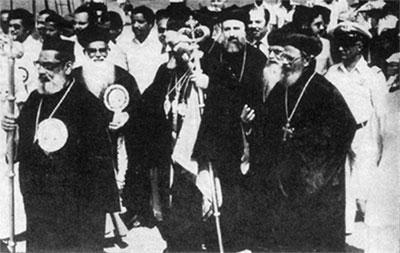 |
Moran Mor Ignatius Zakka I Iwas is the only Patriarch of Antioch who has visited Malankara more than once, first in 1982, two years after his Patriarchal enthronement, then in April 2000 to attend the Episcopal Golden Jubilee of the then Chief Metropolitan of the East Mor Clemis Abraham of Knanaya diocese, in September 2004 during which the year-long 25th anniversary celebrations of the Patriarchal enthronement was inaugurated in Cochin and finally in October 2008 to participate in the sacerdotal golden jubilee of the Metropolitan ordination of Catholicos Aboon Mor Baselios Thomas-I, the regional head of the Universal Syrian Orthodox Church.. While the first Apostolic visit lasted for 50 days, the second was for just 3 days and the third visit lasted for about 2 weeks. In each of these visits millions of faithful thronged at various places to have a glimpse of their beloved spiritual leader. During the first Apostolic visit, His Holiness. consecrated the Holy Myron at Manarcad Marth Mariam church on 27 February 1982. It was the third time in the history of the Church the Holy Myron was consecrated in Malankara. A few days later on 6 March, His Holiness ordained Mor Severios Abraham, as the assistant Metropolitan for Angamali diocese at the Kothamangalam Marthoma Cheriaplly. During the 3rd Apostolic Visit of the Patriarch His Holiness consecrated the Holy Mooron in Malankara once again, after a gap of 22 years. During H.H's 4th apostolic visit, three church fathers, Maphroyno Mor Baselios Shakralla, Mor Koorilose Yuyakkim and Mor Koorilose Paulose Kochuparambil were declared saints and requested the faithful to remember them in the tubden. Another major function was the special session of the Malankara association convened at Puthencuriz under the chairmanship of His Holiness.
1ST APOSTOLIC VISIT - 1982
His Holiness the Patriarch, along with H.B. Catholicos Baselios Paulose II and other Metropolitans ordaining
Assistant Metropolitan for Angamali diocese by name MOR SEVERIOS at Kothamangalam on 6 March 1982
 |
2ND APOSTOLIC VISIT - 2000
H.H. the Patriarch Ignatius Zakka I Iwas addressing the mammoth gathering at the Nehru
Stadium, Kottayam, Kerala on 8th April 2000, during his 2nd Apostolic visit to India
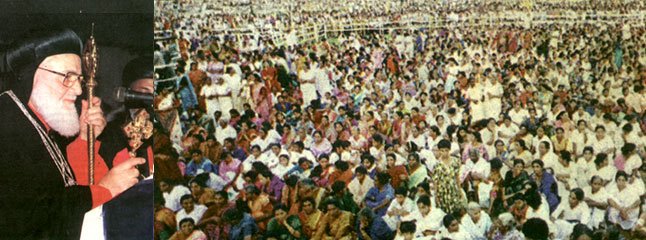 |
3RD APOSTOLIC VISIT - 2004
http://www.syrianchurch.org/ApostolicVisit2004/Home_Page.htm
|
H.H. Ignatius Zakka I Iwas the Patriarch of Antioch and all the East blessing the faithful Venue: Mor Baselios Paulose II Nagar, Marine Drive, Cochin; Sep 21, 2004 |
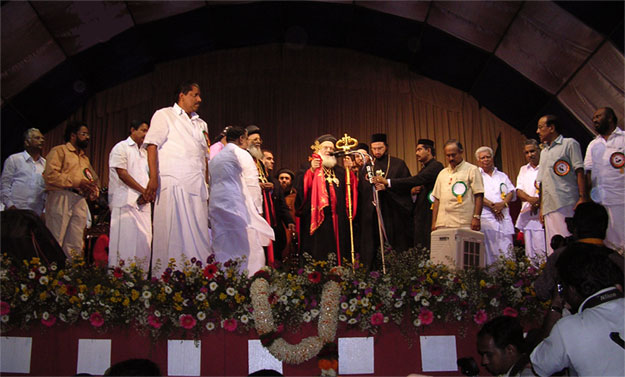 |
|
His Holiness the Patriarch and His Beatitude the Catholicos with the Honorable President of INDIA (left) & Vice President of INDIA (right) |
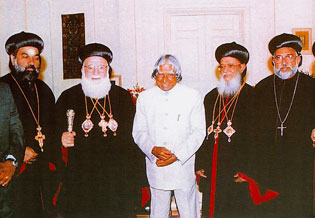 |
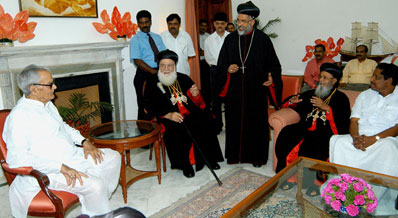 |
|
His Holiness the Patriarch and His Beatitude the
Catholicos with the Honirable Indian Prime Minister & the
leader of the Opposition and the B.J.P. Parliamentary Party leader Shri. L K Advani |
 |
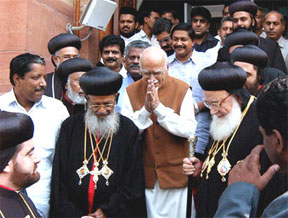 |
4th APOSTOLIC VISIT - 2008
http://www.syriacchristianity.info/AV2008/index.htm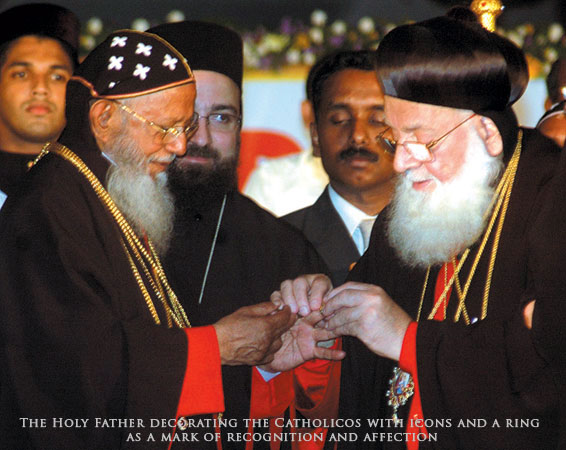
The Holy Myron (Mooron) is one of the seven sacraments of the church. As per the Church canon it is the supreme head of the Church who had to lead the consecration ceremony of Holy Mooron. In the history of Malankara Syrian church, the Holy Mooron were consecrated here barely for four times only when the Patriarchs visited India. The first two consecration ceremonies were held at the Mulanthuruthy Marthoman Church, in AD. 1876 and AD. 1911, by the Patriarchs of the Holy See of Antioch, H.H. Ignatius Pathros IV and H.H. Ignatius Abdulla II respectively, whereas the next two consecration ceremonies were held at the Manarcaud Marth Mariam Cathedral in February 1982 and at the Kothamanagalam Mar Thoma Cheriapally in September 2004 by His Holiness Ignatius Zakka I Iwas.
A brief summary regarding the venue, the date of consecration and other details of the earlier Mooron consecrations in Malankara are given below:
1st Consecration of The Holy Mooron in Malankara
| Venue: | Mulanthururthy Marthoman Church |
| Date of Consecration | 27 August 1876 |
| Consecrated by: | H.H. Ignatius Peter IV (also referred as Pathros III in Malankara) |
| Assisted by: | H.E. Mor Gregorios Abded Aloho, H.E. Mor Divansios Joseph (Pulikottil II), |
| a | Ramban Geevarghese of Chathuruthy (popularly Parumala Thirumeni) |
2nd Consecration of The Holy Mooron in Malankara
| Venue: | Mulanthururthy Marthoman Church |
| Date of Consecration | 19 August 1911 |
| Consecrated by: | H.H. Ignatius Abded' Aloho (Abdulla II) |
| Assisted by: | Mor Ivanios Mathews (Murimattom), Mor Koorilose Paulose (Kochuparambil), |
| a | Mor Athansius Paulose (Valiya Thirumeni), Mor Severious Geevarghese (Edavazikal) |
| a | & Mor Osthatheos Sleeba (Patriarchal delegate) |
3rd Consecration of Holy Mooron in Malankara
| Venue: | Marth Mariam Church, Manarcad |
| Date of Consecration: | 27 February 1982 |
| Consecrated by: | H.H. Ignatius Zakka I Iwas along with H.B. Catholicose Aboon Mor Baselios Paulose II |
| Assisted by: | Mor Athanasius Samuel (U.S), Mor Thimotheos Aphrem (Canada), |
| a | Mor Meletos Barnaba (Homs), Mor Theophilus Saliba (Lebanon), |
| a | Mor Julius Yeshu Cicek (Europe), Mor Clemis Abraham (Knanaya), |
| a | Mor Gregorios Geevarghese (Kottayam), Mor Dionysus Thomas (Angamali), |
| a | Mor Kurillos Kuriakose (Niranam), Mor Julius Yacoub (Simhasana), |
| a | Mor Philoxenos Samuel (Malabar), Mor Thimotheos Yakub (Seminary) |
| a | Mor Theophilos Thomas (Outside Kerala) & Mor Ivanios Philipose (Kandanad) |
4th Consecration of Holy Mooron in Malankara
| Venue: | MarThoma Cheriapally, Kothamangalam |
| Date of Consecration: | 25 September 2004 |
| Consecrated by: | H.H. Ignatius Zakka I Iwas along with H.B. Catholicose Aboon Mor Baselios Thomas I |
| Assisted by: | Mor Philoxenos Yuhanon (Malabar), Mor Polycarpus Geevarghese (E.A.E), |
| a | Mor Thimotheos Thomas (Kottayam & Outside Kerala), Mor Gregorios Joseph (Kochi), |
| Mor Yulius Kuriakose (Simhasana Churches), Mor Koorilos Markose (Niranam), | |
| Mor Ivanios Mathews (Kandanad), Mor Dionysius Geevarghese (Manjanikkara), | |
| Mor Milithios Yuhanon (Kollam Thumpamon), Mor Dioscorus Kuriakose (Malecuriz), | |
| Mor Athanasius Geevarghese (Thrissur), Mor Theophilos Kuriakose (Seminary), | |
| a | Mor Severios Kuriakose(Knanaya), Mor Athanasius Elia Bahi (Patriarchal Assistant), |
| a | Mor Silvanos Pathros (Homs), Mor Milithios Malki (Australia) |
Consecration of Holy Moroon at the Mar Thoma Cheriapally, Kothamangalam in September 2004
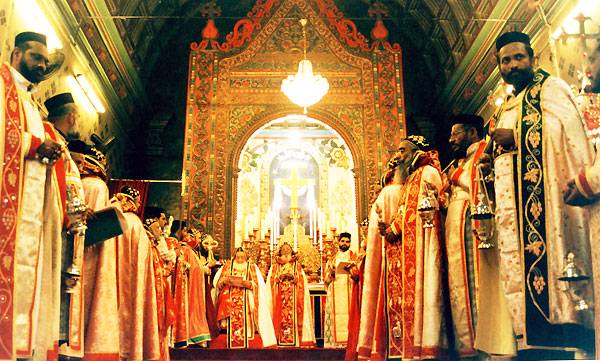 |
Below is enclosed two articles on Holy Chrism (Holy Mooron), the first is reproduced from the book titled
'Veni, Vidi, Vici', published by Dr. D Babu Paul in 1982 & the second is an article
by Chev. Prof. Dr. C. A. Ninan, Ph.D.,D.Litt, D.D., provided to us by Dr. Paul Samuel
I. HOLY MOORON
The Holy Mooron is one of the seven sacraments in the church. It is called confirmation. It is so called because it confirms the Christian in his faith and it strengthens him in his fight against satan. It is the Holy Mooron which gives the faithful the strength of the Holy Spirit. Again it is the Holy Mooron which gives the Holy Spirit's gifts to stand firm in true faith and to grow spiritually. The consecration of Holy Mooron is the sacrament of sacraments.
Traditions
The priests in the Old Testament times were from Aaron's family. But after our Lord's incarnation any man who is a good Christian can became a priest. In that sense all Christians are called to priesthood. St. Peter says (I Peter 2:9) we are chosen generation and a royal priesthood. That is why the New Testament Church gives Holy Mooron to all Christians while the Old Testament gave it only to members of Aaron's family.
As the church grew it became impossible for the Apostles to reach everywhere to lay hands. Therefore, inspired by the Holy Spirit, they consecrated Holy Mooron. The Apostles took the perfumes which were used at the burial of Jesus, mixed it with oil and consecrated it in the Upper Room. Since then, whenever Holy Mooron is consecrated, a little Holy Mooron consecrated earlier, is also added. This is to ensure continuity from apostolic times.
Holy Mooron is the mark of the Christian. Clemis of Rome says that without anointing and thereby accepting the grace of the Holy Spirit the baptized do not become Christians. St. Paul says that we are unto God the sweet savour of Christ (2 Cor. 2:15). That sweet savour, we become, through the Holy Mooron. By Holy mooron we are sealed in true faith.
When man sinned, God declared that he will not let Holy Spirit dwell in man. Now that we are saved by Jesus, Holy Spirit dwells in us. Holy Spirit comes to us through Holy mooron. When Holy Spirit dwells in us we must smell the sweet smell of Jesus, as St. Paul tells us. Otherwise the gift of God will be in vain. We are to be in Christ and Christ is to be in us: it is the Holy Mooron which helps us to do so.
Preparations for the Consecration of Holy Mooron
The consecration of the Holy Mooron is preceded by elaborate preparations. Fruits are collected from selected olive trees in the months of September and October. They are cleaned and squeezed. To this juice is then added pepper, spices and perfumes. The whole thing is then ground to a fine flour, which is mixed with oil and kept in jars which will then be heated by steam for three hours. After so heating, mea, a preservative is added. Again steam heating is done for one hour. On the day of consecration balsam is added.
For the consecration of Holy Mooron the Patriarch wears vestments. Besides the Catholicos and the Metropolitans, 12 priests, 12 deacons and 12 yavuppadeacons take part. 12 censors, 12 maruvahatas and 12 candles are taken for the procession. In fact there are two processions. During the first the Patriarch leaves the church through the door on the northern side, censor in hand, accompanied by two deacons with maruvahatas and two yavuppadeacons with candles. After going round, the Patriarch re-enters the church through the southern door. Long prayers follow.
The first procession during the Consecration of Holy Mooron (1982 - Manracad Church).
The picture shows Korooso Dashroro the Rt. Rev. Dr. Kurien Kaniamparambil Corepiscopo,
the Very Revd. Kuriakose Vettikummel and Revd. Frs. Kurikose Ittyadathu and Jesus Chirapurath besides others
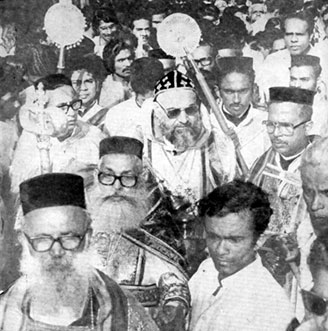 |
The readings from the Old Testament and the Acts and Epistles, normally read by deacons, are read at the time of consecration of Holy Mooron by Metropolitans: it shows how important the occasion is. After the reading from Isiah the Patriarch accompanied by the Catholicos goes to an area in the sanctum sanctorum covered by curtains, and mixes balsam in secret. Then the Patriarch enters the tent, hiding a bottle under his vestment. Four Corepiscopos hold the tent during the second procession which now starts. The tent is preceded by 12 yavuppadeacons with candles, 12 deacons with maruvahatas covering the tent, a Corepiscopo with the cross, another with the gospel, the archdeacon with sceptre, and 12 priests fully attired and holding the censors. Before commencing the procession, the Patriarch says Halle-luiah thrice and the congregation says 'Tesubuhato Laloho Bamerowme'.
|
|
All priests, deacons and sub deacons present, join the procession with lighted candles in their hands. At the doors of the church - north, west and south - the Catholicos puts frankincense in the thurible. At the end of the procession the tent covering the Patriarch is taken to the Madboho. The bottles containing the oil to be consecrated is then covered with sosappa and the service begins, with 12 deacons holding maruvahatas around the altar and 12 priests offering incense.
The service is very similar to the Holy Qurbono. There is recitation of the creed, the prayer of peace, call to lift up the hearts, the angelic glorification, invocation of the Holy Ghost and the Lord's prayer. Finally there is the "celebration of the bottle" and the blessing of the people with the bottle containing the consecrated oil.
| Consecration of Holy Mooron |
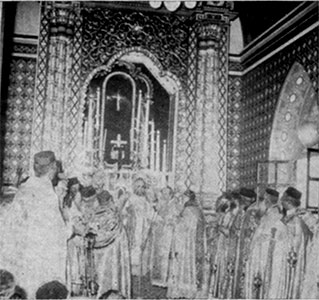 |
The yavuppadeacons represent the prophets and the deacons the apostles. The maruvahatas stand for seraphins. The 12 censors remind that God who live sin all is the same; censors are twelve, but all give out the same good smell. The 12 candles stand for the orthodox teaching of the 12 apostles. The Patriarch wears white vestments because in this service he represents Christ who is the lamb without blemish. The first procession symbolizes the Old Testament and the sinful woman's journey to the shop to buy the perfume; the second, the New Testament, the anointing by the woman, the crucifixion, the resurrection and the Pentecost. The Patriarch is hidden in a tent to remind us of Moses having a veil on his face, vide Exodus.
Article is from the book Veni Vidi Vici, by Dr. D Babu Paul
II. HOLY MOORON
The Church is the mystic body of Christ and so the life of the church is life in Christ. Christians live, move and have their beings in Christ (Acts 17:28).This is sacramental life for which Christians are called.
Sacraments are means of grace instituted by Jesus Christ for the salvation of mankind. Through them the grace of God descends and indwells upon the Church and its members. In the Syrian Orthodox Church of Antioch, there are seven sacraments of which Holy Baptism, Holy Chrism and Holy Eucharist are the most important. Baptism is the sacrament of entry into the church and only those who are baptized according to the teaching of the Church can partake of the sacrament of Holy Eucharist. The Holy Chrism is the holiest of anointing oils of the Church, also called the fragrance of the Holy Spirit and is used to chrismate the water of Baptism( in the baptismal font),signing in the name of Holy Spirit and also for post-Baptismal anointing. It is also used to consecrate church buildings, the altar and the altar stone (tablitho).The Holy Chrism itself is consecrated in the longest of the ceremonies of Syrian Orthodox Church by the Supreme Head of Church viz, Patriarch of Antioch and All the East. In our Church, only the Patriarch consecrates the Holy Chrism. The Bishops alone can transfer into smaller bottles and duly ordained priests can only sacramentally handle. Other clergy or laity is forbidden to even to touch it. The Holy Chrism is kept in a special casket in the ‘Holy of Holies’ (madbho) in the church.
The Apostles of Christ received Baptism in the Holy Spirit on the day of Pentecost: and on the next day they consecrated the Holy Chrism using olive oil and spices (John 19:40) collected from the tomb of Jesus Christ .Using this Holy Chrism they consecrated the upper hall of St: Mark’s as the first church in Christendom in the name of St: Mary, Mother of God.
The Holy Chrism of Syrian Orthodox Church of Antioch has a history dating back to the first consecration by the Holy Apostles headed by St: Peter. This again is a continuation of Old Testament oil of anointment of Moses as dictated by “YHWH’ (God) (Exodus 30:22-33) for anointing the Arc of Covenant, Levites, Kings and Prophets. In fact the Prophets carried the anointing oil in horns along with them.
In the New Testament Church, the Holy Chrism signifies Christ himself. In its constitution and consecration, the mysteries of incarnation of the word and of the person of Christ himself are signified in and through the Holy Chrism.
The consecration ceremony of the Holy Chrism (Mooron Koodasha) is conducted in two parts. Sufficiently before the date of actual ceremony, pure olive oil is mixed and boiled along with the following spices in the measures given below.
| 1. | Pure Olive oil - 400 suso |
| (prepared from seed coat of Olea europea) | |
| 2. | Nardeen (Nardostachys jatamansi) root - 60 suso |
| 3. | Clove (Eugenia caryophyllata) flower bud ( Mal. – grampoo)–20 suso |
| 4. | Myristica fragrance seed (Mal.- jathi) - 20 suso |
| 5. | Crocus sativus flower bud - 20 suso |
| 6. | Zingiber officionale (Mal.- dried inchi / chukku) rhizome – 20 suso |
| 7. | Piper nigrum (Black pepper) – 20 suso |
| 8. | Cinnamomum verum (Mal.-Karuva patta) – 50 suso |
Items 2-8 are powdered and mixed in olive oil ( item 1).And the bottles containing these are suspended by iron wires in boiling water in a copper vessel for 3 hours. After this, 60 suso of green ‘njerias’ is added into the bottles and boiled for one more hour. On cooling the oil is filtered and transferred to bottles and is ready for consecration. On the day of consecration it is taken into the ‘Basgasa room’ of the church. Side by side with this is also brought and placed Balsamoun oil (prepared from immature seeds of Balanites aegyptica).
The consecration service of the Holy Mooron is conducted in two parts with elaborate prayers and songs. At the end of first service, the Chief Celebrant( Patriarch) with full vestments enters the Basgasa room and mixes the medicated olive oil with balsamoun signifying the fusion of divinity and humanity in the person of Jesus Christ( Unity indivisible). It symbolizes that Christ accepted our humble humanity and gave us His Divine Godhood.
There are two processions during the service. The first procession in the first part of the service is headed by a Metropolitan and is symbolic of the way of sinful woman who went out to buy oil for anointing Christ for expiation of her sins. The second procession takes out with the Patriarch carrying the sacred oil and covered on all sides with ‘Cububso’ which is again covered by twelve ‘marvahthos’ carried by 12 deacons signifying seraphims which cover their faces by 12 wings. With this procession goes all the attending Metropolitans with full vestments, 12 priests in full vestments with burning censors and 12 yapudyaknos with 12 candles. The first procession also sets the route in which the second procession is to go. As the procession of dignitaries goes by, the congregation stays around the church. At the end of the service the Holy Chrism is waved in four directions (Howde malache) and the congregation is blessed with the newly consecrated Holy Mooron.
The consecration of the Holy Mooron is the most sacred and magnificent ceremony of the Church. It is highly charged with spirituality and link back in OT connection to the fragrant oil prepared by Moses according to divine recipe received at Mount Sinai. It is through use of the Holy Chrism that all members of Church become heirs of the Royal Priesthood the Church is .(1 Peter2:9).
It is the teaching of the Church that where the Holy Chrism is, there Christ himself is. Baptism in chrismated water signifies death and resurrection along with Christ (Romans 6:4).One wears Christ via chrismation of his entire body at the close of the Holy baptism. Here, he is also signed with Holy Chrism for eternal life in the form of cross in the name of the Father, the Son and the Holy Ghost. Without chrismation baptism is not completed at all.
Just as the bread and wine of Holy Eucharist becomes the body and blood of Christ, the Holy Chrism represents the life and self of Christ. These three mysteries together constitute the centre of the inner life of the Church to which all its members belong together. These three sacraments bring purity to the Church and protects her form the evil designs of the adversary (Satan). The Church flourishes under the banner of the Cross, the anointing of the Holy Chrism and partaking of Holy Eucharist in its march to life everlasting.
Chev. Prof. Dr. C. A. Ninan, Ph.D.,D.Litt, D.D.

© MSCR - Malankara Syriac Christian Resources
Facebook.com/SyriacChristianity
Email: mscrp@live.com